After the metropolis and smog of southern california we were glad to be out at sea again headed for more wilderness. But the weather didn't coorporate, the autopilot gear failed, we got smashed landing the dinghy, shared Thanks Giving with cruisers, did a lot of hiking, and eventually found our way to Mazatlan.
Phew! Were we glad to be leaving southern California. The high costs, the garbage in the water, and the over-zealous military in San Diego was more than we could bare. We cast our absentee ballots, stocked up, arranged our paperwork for Mexico and bid goodbye. Our longing for peace and quiet had us taking any weather window we could find.
Taking a look at the map, the red arrows show the places where we anchored. The scale is missing, but from San Diego to Cabo San Lucas (the black arrow), it is about 715 miles. Our entire route will carry us over 1000 miles.

As we departed San Diego, the Star of India was taking tourists out for a sail on the bay. Beautiful ship under sail.

The weather forecast promised light winds as we left San Diego bound for Bahia Tortuga, 350 miles away. Since this distance is beyond our fuel range, we were committed to sail or drift our way south. We tried to escape San Diego quickly, but not before one last killing machine tried to run us down.

"Warship 53" was bearing down on us before turning abruptly. It somehow seemed a fitting farewell (the dot in front of their bow is the junk rigged boat, "Batwing").
As we continued to drift across the border, the wind strengthened and the sun began to set. We celebrated our crossing of the border with a beer and a quiet sigh of relief.

Not long after sunset the wind built to a hardy 25 knots and the seas started to get bumpy. We reduced our sail to just the genoa and continued to fly along at about 6-8 knots. "Batwing" had departed San Diego at the same time as us, but they had reefed down and were quickly dropping out of radio contact. As the weather got rougher and the winds got stronger, we could barely hear them over the radio. They were heaving-to (or stopping their boat) until the weather improved. We continued on.
The weather stayed rough for two days. On the second day, we reduced sail again to just the staysail and that slowed us way down to 4.5 knots. A little disappointing, after our screaming 24 hour run of 137 miles (an average of 5.7 knots!!) But it was more comfortable as the seas were getting rougher and rougher.
Late into the night on the second day, the waves were crashing all around us. They were coming at crazy angles. One would slam our stern and another would crash into our beam, sending spray over the top of the boat. A particularly large wave broke right on our stern and mangled our self-steering gear.
We suddenly lurched off course and began reaching rapidly across the waves. I got out two large wrenches and worked furiously on the gear as Sherrell held the spotlight on the twisted metal. I guess 1/8 inch thick bronze with holes drilled in it wasn't quite strong enough. I bent it back into place and we were soon back on course, but the crew was shaken.
We bounced along all night and made the decision to skirt behind one of the large 20 mile long islands off the coast to get out of the rough weather. Since we were a long way off shore (about 50 miles), it took some time to gybe all the way back behind the island.
As soon as we were in the lee of the island (Isla Cedros) the 4,000 foot tall mountains cut the winds and seas down to nothing. We were only about 60 miles from Bahia Tortuga, so we felt it was ok to motor a little bit through the calms, so we could arrive in the bay by daylight.
We motored for about 6 hours until the wind picked up again, and then we continued to sail into the bay. Just as we were entering, we heard a call on the radio from "Batwing". Apparently, they had made up time by changing course and following the coastline after heaving-to, instead of heading out as we had. After 80 hours of sailing apart, they arrived and anchored about 45 minutes after us.
We were relieved to be out of the rough winds, and were even more excited to have sailed over 90% of the distance.
The town in Bahia Tortuga had all the basics: produce, water, ice and internet access. Much of their produce was better stocked than many of the places in Northern B.C. and Alaska -- pretty impressive for such a small dusty town.
There were a lot of other cruising boats in the anchorage and we decided to meet on the beach for lunch.

Landing on this beach requires negotiating the breaking surf. We've landed in surf before, but today we weren't paying attention. I rowed the boat slowly, distracted by chatting until I realized we were already near the beach. Before I was ready for it, we were pushed into the area where the waves were breaking. One broke and lifted our stern up and we started to surf, but then the boat twisted sideways and flipped over. I bailed out and tried to keep the 120 lb. dinghy from crushing Sherrell. Once she was clear, I lifted our outboard out of the water and a few people stepped in to help drag it out of the surf and empty the sand and water.
Sherrell was lucky. She had a 10 inch long bruise on her thigh and various dings, but no permanent damage. We spent the afternoon drying off and draining the water out of the engine. Fortunately, the engine recovered ok, but I'll need to take it apart and clean it out when we have access to fresh water.
The crash landing aside, the bay was beautiful and full of sardines. The sardines brought in the sea lions (called "los Lobos" by the locals), dolphins, pelicans and lots of other fish. We could watch the dolphins and sea lions swimming just a few feet from the boat. Of course, the only photo I got was one in the distance, but at times there were as many as 6 or 7 swimming together.

After making yet another change to the self-steering gear by making some new parts and adding extra clearance to the moving pieces, we were ready to get underway again.
We wanted to wait for a favorable forecast, and after the last 80 hour rough ride, we decided that light winds would be good enough. So we departed again, with a very light breeze for the next 235 mile leg. As we sailed out of the bay another larger sailboat started sailing behind us. They started to quickly overtake us in the light wind, so we decided to heat things up. We hoisted our Halloween spinnaker (black, yellow, orange and white) and quickly left them behind.
Later in the evening, the wind picked up again and we dropped the spinnaker and continued with the main and the genoa. By early the next morning, the wind died. We were less than half way to our destination, Bahia Santa Maria, and 30 miles from a possible anchorage. Since we were both tired, and didn't want to motor all the next day and night (due to no wind), we turned on the motor, and headed due East to Abreojos ("Open your eyes!"). We spent the night there, hoping to get some sleep, but at 2am the wind picked up from the South which blows directly into the anchorage. It became choppy and bouncy, and we were concerned we would have to pull up the anchor and get the hell out of there.
I set the GPS on anchor watch, and set a timer for 60 minutes. If the conditions got worse or we started to drag towards the beach, we were ready to depart. Needless to say, it wasn't the rest stop we hoped for.
The wind died back down around 5am and started to shift back to the North. We got a little sleep, but departed at first light for the last 140 mile leg.
With full sails up, we screamed along in the nice 15-20 knot breeze. It was perfect sailing weather! The seas were tame (<8 feet) and the wind was on our beam. We even saw about 7 sea turtles swimming around in the water when we were offshore about 50 miles (the brown blob with white head below is a turtle). And how about the color of that water?
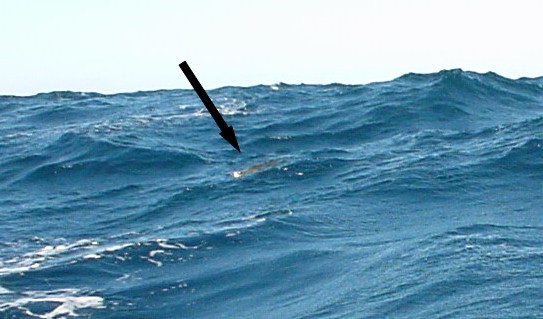
I think we might have accidentally bumped one, but its hard shell protected it from any damage, and it went about swimming around as if nothing happened.
The wind picked up some more and we reefed the main and continued the great sail towards Bahia Santa Maria.
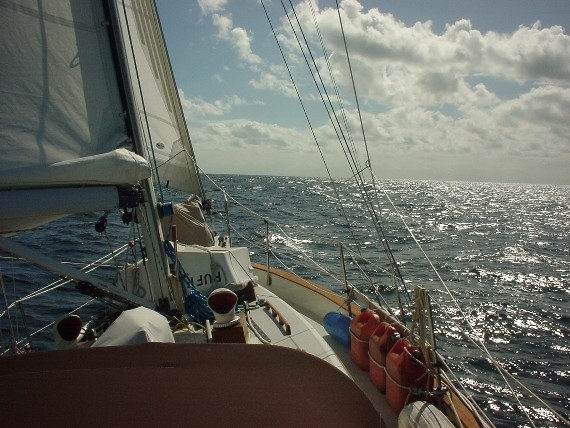
When we arrived at the entrance of the bay, the wind was blowing about 25 knots and the sea was getting stirred up again. We were really happy to be pulling into this nice remote and protected anchorage. There were about 17 other sailboats in the bay, several of them had departed before us at Bahia Tortuga while we were still busy working on our steering gear.
Bahia Santa Maria is a bay of amazing beauty. The subtle tones of the desert and the crystal clear water teeming with fish made this one of our favorite anchorages!
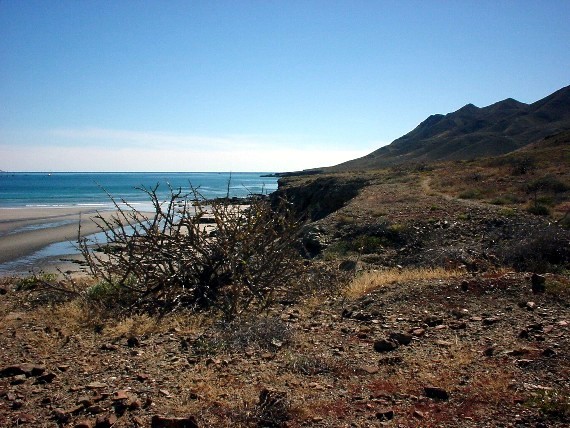
There are hiking trails all over the hillsides, a large saltwater lagoon with green mangroves and small fishing villages, and lots of different flowering cacti.
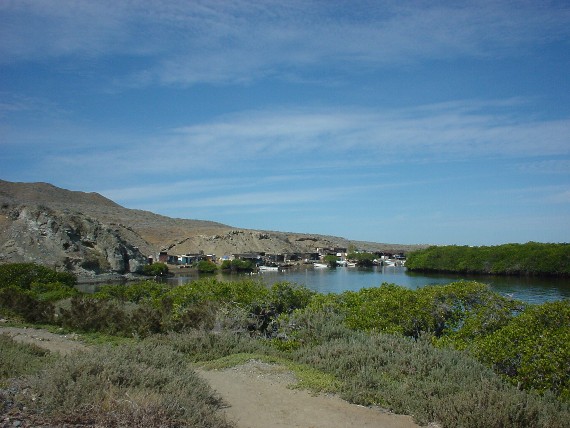
This bay was a great place to recharge ourselves and celebrate our 500+ mile trip into Mexico. Since Thanksgiving was being observed by family and friends in the U.S., we decided to hold a potluck and have a small feast too.
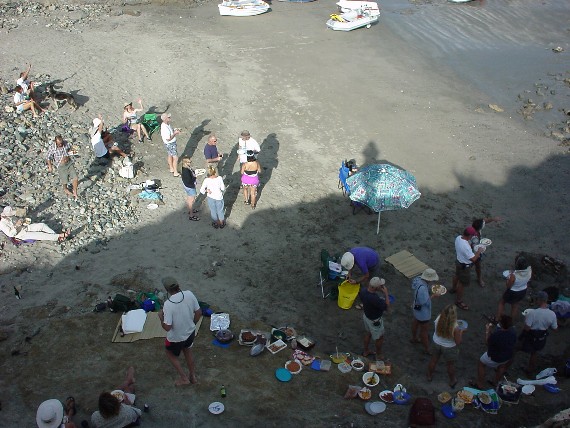
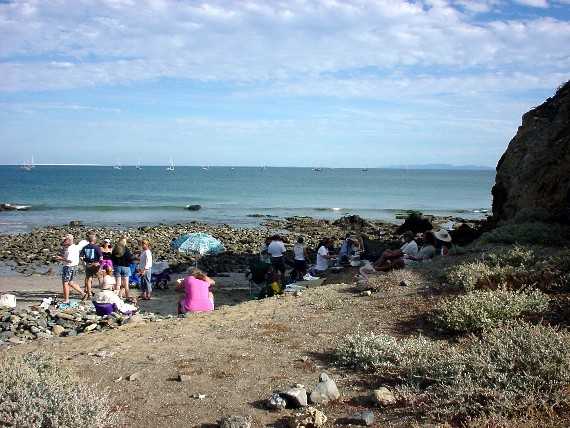
After the feast, we built a small fire from some of the driftwood that another cruiser and I hauled from the far side of the cape. After all it is winter here and we were all starting to fill the chill with just shorts on (ha ha). Notice how Sherrell (taking the photo) and I are the only ones really prepared for maximum laziness -- chairs!
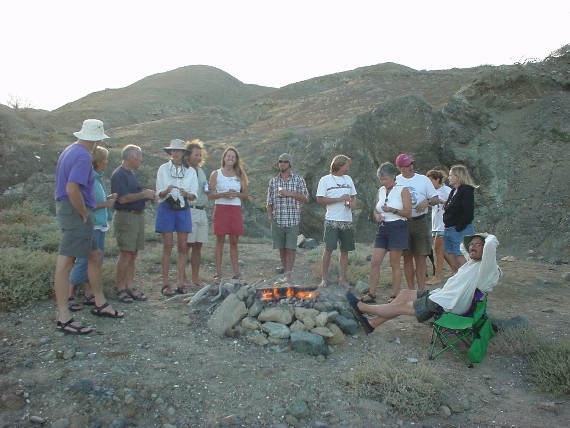
After two weeks of wilderness, we decided to spoil ourselves and head to the next bay, Bahia Magdalena. They had a water desalination plant and a small town.
We started off sailing in light winds. As we exited Bahia Santa Maria, we saw a whale feeding in the current. A sign that the whale migration to this area might be beginning soon. Whales come from all over to breed and calf in this area of warm protected water.
We kept sailing, and watching for whales well into the late afternoon. For most of the day it was your typical light air sailing, chasing puffs and flogging in the lulls. Then the thermal winds off the land started to pick up, and we went screaming down the coast. We sailed into the entrance of Bahia Magdalena as the sun was setting. To get to the anchorage before dark, we fired up the motor and powered upwind against the choppy waves.
As darkness fell, we anchored in the bay and found several of the boats there, one of them the ever trusty "Batwing", had already arranged for a panga (open speed boat) to take us to the nearby city of San Carlos the next morning, to shop at the farmer's market held on Wednesdays. What luck! Fresh produce! We were expecting to have to keep living on dry goods and canned food until we reached Mazatlan.
That night though, we suffered through a strong wind from the NE, from which direction there is a long stretch of water. The waves in the bay built up an impressive chop, and soon we were all bucking the waves all night long. "Batwing" drug and had to re-anchor in the middle of the night, and we had to move to the pilot berths to hope in vain for a calmer place to sleep. With the GPS keeping an anchor watch and us occasionally making visual checks on our position, we rode out the winds until early morning.
Exhausted, but excited about getting some fresh produce, we were picked up by the Port Captain, Gregorie, at 8:30 am and went to San Carlos. We stocked up with about all we could carry and indulged our selves in fresh veggies, fruit, and even a 6 pack of bad expensive Modelo beer.
The next day, after stuffing ourselves with food, we took a hike to the nearby lagoon. It was full of birds: King Fishers, Ospreys, Herons, Ibis and more.
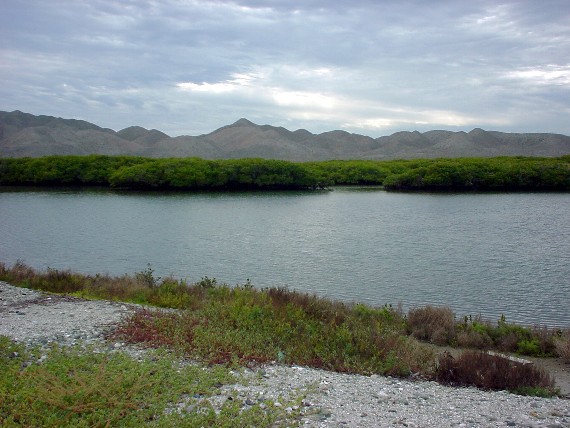
It is amazing what type of plant and animal life can grow in these areas. After a brief and light rain, many of the plants were flowering!

We hiked up a tall ridge to look out over the ocean where we could spot whales splashing and feeding in the water.
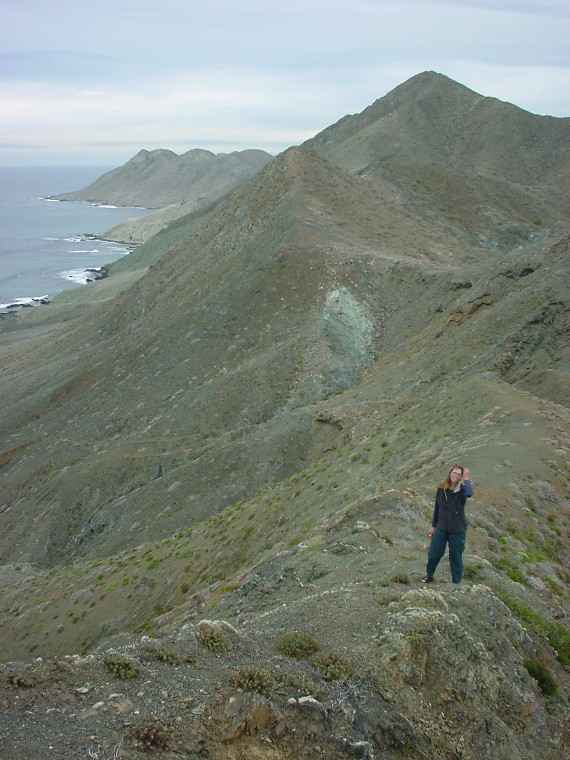
Along the trail we found something peculiar. As if we were transported back to Asia, we found a shrine. This time, though, it wasn't to a Buddhist God but to a Christian one. It was interesting to see this here. The town already had a very nice church, so why was someone inspired to build this little shrine with lots of pictures of the Virgin Mary? There were burnt candles and silk flowers strewn about -- signs of obvious use.
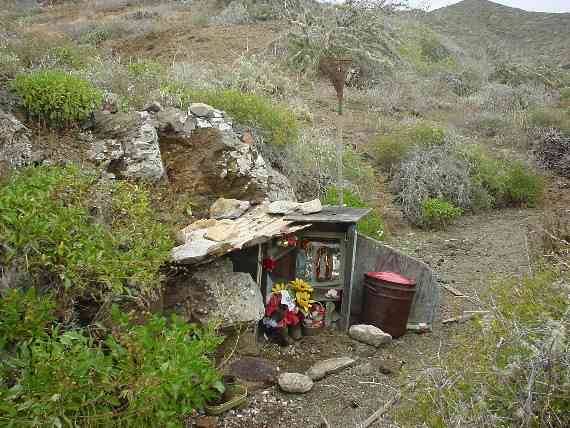
Later when walking, we came across a large graveyard, a long way from this shrine, so we were quite sure it served its own unique purpose.
We hung out in Magdalena Bay for a few more days, waiting for good weather to start our next leg down around Cabo Falso (where Cabo San Lucas is). This is a long passage, about 220 miles, a good solid 40 hours.
Once the weather looked favorable, we set out with "Batwing" around noon. It was light air sailing again. "Batwing" had to motor because the swells were tossing around their junk sails too much. We were able to sail at about 4 knots or so for the first 24 hours. During the night the wind suddenly started to howl out of the north. Starting, of course, just as we were struggling to avoid a large commercial ship that was coming right at us. We managed to wrestle the pole down and gybe the boat, but not before sailing out of control directly at the ship.
How is it that out of thousands of miles of ocean, these ships show up out of no where and head right for us? It's always pitch black, and the wind suddenly pipes up and an emergency quickly ensues. We went way out of our way to hug the coast, going inside the major points of land, to make sure we would be out of the shipping traffic. This time "Batwing" was closer to the ship than us, and in the waves, we couldn't spot them but we were worried that they might be in trouble.
All of a sudden all of the lights came on on the ship. Normally they run with two tiny lights, each about 300-500 feet apart. Their lights are disgustingly tiny and so far apart they are hard to spot in the dark. But when they hit the switch, it suddenly lit up like a city! We wondered if the captain was worried about our rapid sail towards them (when the wind piped up). We altered course as much as we could, while struggling with the sails, and our radar showed us clear of their path, so we started to worry about "Batwing" and called them on the radio.
They came on and said they had managed to make radio contact with the bridge and communicated their position and course. The ship indicated they had spotted us and I guess as a courtesy turned on some real lights so we could actually see them.
Well, that set the tone for the night. We thought we were clever in picking a route that took us clear of all the potential shipping, only to have them find us.
The next day, the winds had really gotten light and we powered up the motor. Unfortunately, we had light winds then strong head winds which forced us to keep motoring the rest of the trip.
As we approached Cabo Falso, the major milestone for this coast, at 2am, a large cruise ship tried to run us down. This ship was a little more difficult to avoid. They had plenty of lights on, but they also had a lot of Christmas decorations (red and green) which made a confused mess of finding their running lights (red and green). The running lights are different colors to tell you which way the vessel is heading. With all their decorations, it looked like the boat was spinning around in circles.
Sherrell made radio contact with the cruise ship to make sure they knew we were there. He indicated that he saw both boats and was going to clear us by about 0.5 miles. Damn close for a ship of that size! He said that he would turn some more and go around us by 1.0 miles. Once again "Batwing" was closer to the ship, so we let them know about making contact with the ship and the captain's intentions.
They were as bewildered by the ship's navigation lights as we were and they were convinced the ship was coming right at them. "Batwing" called the cruise ship and told them it looked like they were coming right at them. The captain commented sharply back to them, "We will clear you by about 1 mile. I have no concerns."
We asked "Batwing" to switch to a different channel so we could talk with them. As we were plotting both boats on the radar, we told them it looked like they would definitely clear Batwing by about 0.5 mile. Just then the captain of the cruise ship interrupted -- he had been quietly following our conversations on a channel we thought we had to ourselves. He said, "You must understand that our ship is yawing in the ocean swells so it appears that we are changing course, but we are not."
Diane on "Batwing" said, "Sorry. It is just unnerving being in a small boat with a large ship heading towards us."
The captain's thick Scottish brogue came back with, "Well, I make it a habit not to run over small boats."
That released some nervous tension. Over the radio Diane laughed and asked him where they came from and where they were going.
"We came from Florida. We are doing a Trans-Panama cruise with about 1600 people on board. Our destination is San Diego after our stop in Cabo."
I wonder if the people on these cruise ships know the terror that sometimes goes on in the dark of the night right outside their windows. As it turned out, they didn't really alter their course and only cleared Batwing by about 0.4 miles. The high speed that these large ships travel, it is often difficult to tell their exact course. It is even more difficult for them to change their direction. The only real choice small boats have is to quickly determine their course and floor it out of their way. If they don't answer their radio, as many don't, the sailor is forced to go with their instincts and cross their fingers.
Fortunately, that was the last of the large ships that were close to us. We rounded Cabo Falso at 2:30 am. We turned east and started to head for Los Frailes.
South of the cape, the wind and waves get pretty rough. We had planned to be only a few miles off the shore and then head back in towards land to get out of the rough water. This didn't go exactly to plan because "Batwing" decided to alter their route and head further out. We were 2 miles outside of them so we had to head further out as well.
Sherrell told them we didn't want to keep going out because it was getting much rougher, but they wanted to get to their waypoint. After a stretch of time, the waves and the wind got really rough. We were getting tossed all over. Sherrell decided to alter course back to land slowly while not putting us on a collision course with "Batwing". As "Batwing" began to get closer to our outside position, they realized what Sherrell had been telling them and dramatically altered course to go back in towards land. We rocked and rolled in the rough conditions for about 2 hours before getting about 2 miles from the coast where it calmed down.
I was concerned about this portion of the leg, because it required us to go North into the Sea of Cortez, which was expecting high winds later in the day. Since we hit that rough patch, I started looking for alternatives to divert to if it got really rough.
Cabo San Lucas was the only choice. We wanted to avoid that because it is a VERY expensive tourist town. I filed that thought away under my "Any Port In a Storm" list, and hoped that our smoother water and calmer winds close to shore would hold out.
Naturally it didn't. About 5 hours later around 9 am, it got worse. But we were only about 3 or 4 hours from Los Frailes, so turning back didn't make any sense. We pounded into a stiff 25 knot wind with 6-8 foot breaking wind waves. Our decks were getting drenched, but our dodger and combings kept us dry. We had to occasionally duck a large spray, but for the most part we at least stayed dry.
Our new, more powerful engine was put to task as we pushed through the sea and wind. There is no greater frustration than to be within sight of a safe anchorage after a long passage and yet have conditions so rough you wonder if you'll make it before sunset.
We slogged our way up the shore and into the bay and to our great relief we dropped anchor in Los Frailes. The wind screamed and howled at about 30 knots, but tucked in behind the beach, the sea was calm. A rough ending to our 40 hour passage.
The anchorage was nicely protected from the seas though the wind was still felt. All the boats huddled up close to the northern shore for protection.
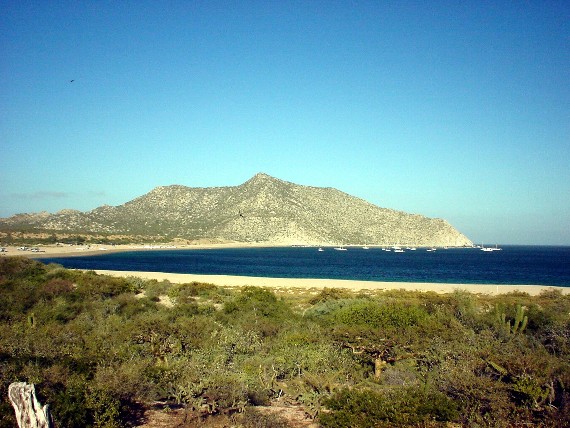
The vegetation receives more moisture here, so it is a little greener and the cacti grow big!
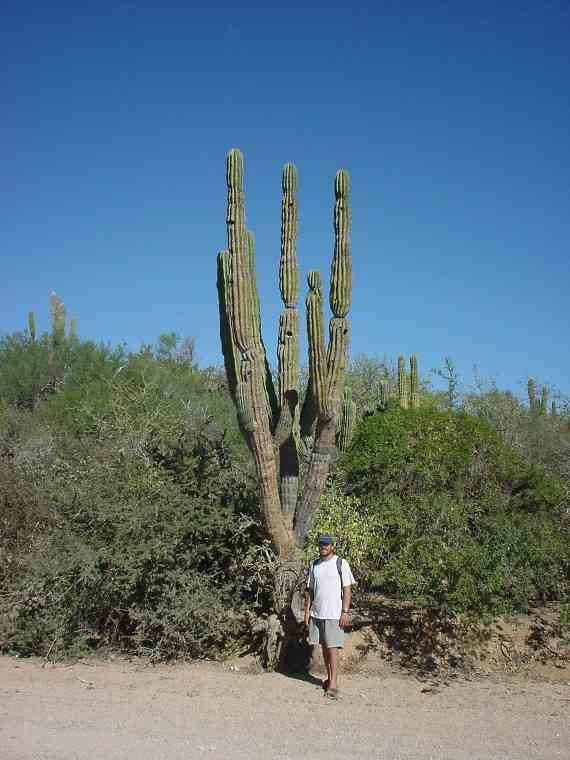
And of course Jezebel loves the warmer weather. You can see her helping out with all the boat work and keeping the place ship-shape.
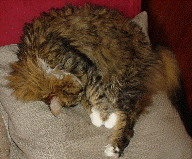
There are also some odd sights around Southern Baha, like a well in the middle of the desert with crystal clear water.
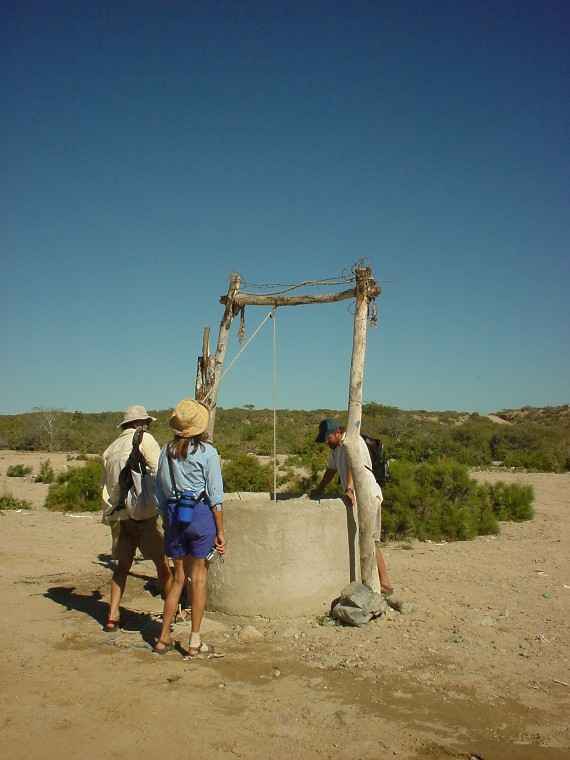
And if that doesn't seem strange enough, there's always a crowd just hanging out waiting from something to die.
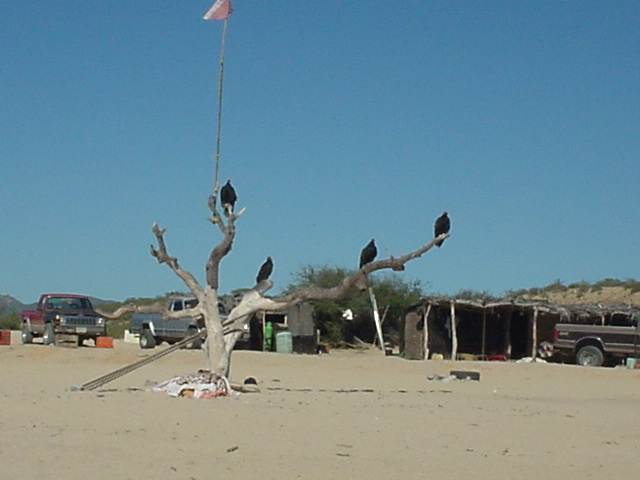
We found a small restaurant/bar/store that had really cold beer and good food. The cook made vegetarian dishes for us. It was so good, we went there twice!
Mazatlan, our major stopping point along this coast, lies due east from Los Frailes, about 165 miles. This area is called the "Southern Crossing" because you're crossing the south end of the Sea of Cortez. The Sea of Cortez is a 900 mile long, 150+ mile wide sea, similar in conditions to Juan de Fuca Strait with the wind funneling down it like a chute. Like Juan de Fuca in Washington, the wind waves build up into small houses and many boats have gotten the snot beat out of them in this crossing. We waited patiently for the winds to die down and when the forecast looked calm, we bolted.
We set out at 4am, expecting the passage to take about 36 hours. After just the first 5 miles, we found ourselves once again dodging a large ship. This one was a tanker and it was difficult to judge his path. We ended up turning around to make sure we were clear of the beast. What a start!
Happily, the rest of the trip was fairly free of traffic, but we heard other boats on the VHF struggling to avoid cruise ships, ferries and tankers. We sailed a nice beam reach at 6 to 7 knots for about 10 hours before the wind ran out. Then we turned on the engine, eager to arrive in Mazatlan for rest, and it stayed on until we arrived about 30 hours later.
Upon our arrival, we found the channel to the marina closed for several hours while they dredged it. Apparently they do this a lot here. Depressing, but tolerable, we anchored behind a nearby island to wait until the equipment was shut down so we could enter.
We'll stay in Marina Mazatlan for a month or so while we get some rest and visit Sherrell's Dad for the holidays. We aren't sure what our plans are next, but we will likely head south a little ways down the mainland coast, before heading back North and into the Sea of Cortez for summer.
Related Slog Links:



